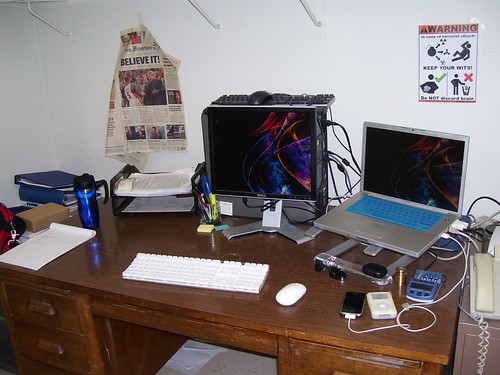Recently. I’ve found the incessant screaming debate about and between Apple and its ban on the as-yet nonexistent mobile Flash player to be somewhat familiar. At first, I thought that it was just because its been going in since 2007 with the original iPhone announcement sans Flash. But no, we’ve had this exact same debate before, in the very recent past. In fact, its so recent, I’m surprised that it took this long for anyone to bring it back up.
Flash isn’t the first major third-party format that Apple has refused to bundle with its mobile devices. Years ago, when the only iThing was the scrollwheel iPod, we had another debate that sounded pretty similar to the one we’re having today. All you have to do is take Flash and Adobe, and replace them with WMA and Microsoft. Oh, and you can replace wannabe iPhone Flash developers with Real, Napster, Sandisk, Rio and a host of other names that no one gives a shit about anymore.
Back in 2003-2006, there were a host of Microsoft-supported players and services that were based on WMA. In 2004, Microsoft introduced Plays for Sure with the promise that this huge ecosystem of devices, services and software would all, well, play for sure. The same people who today are complaining about Apple’s draconian control over its own platform are the same ones who were predicting that the iPod would suffer the same fate that the Mac did in the 90’s. (Ironically, these same people are now making the same prediction about iPhone OS devices vs Android, using the same flawed reasoning.)
Back then, there was a constant barrage of stories about how the iPod’s hardware could decode WMA, but Apple locked it down for their own (evil?) purposes. Or the fact that if some hapless Windows user ripped their CDs with Windows Media Player, they’d be confused and frustrated when they wouldn’t be able to transfer those tracks to their new iPod. Even though iTunes for Windows is able to transcode WMA files to MP3 or AAC. Of course, in 2006, Microsoft killed Plays for Sure when it introduced Zune, using Apple’s iPod (and later iPhone) model.
Oh, and about AAC. Did you know that it just isn’t that much better than WMA? Kinda sounds like the argument that HTML5 can’t replace Flash because it doesn’t do everything that Flash does. Of course those things involve stuff like slapping DRM on streaming video or installing spyware Flash cookies that advertisers can use to track you across multiple websites (and that you can’t remove or prevent without messing with the settings of a folder buried in your /Library folder. Something no normal user would ever even find out about, let alone do.)
Am I saying that the Flash/iPhone OS situation is exactly like the WMA/iPod issue? Of course not. But they are analogous. Both involve Apple exerting control over its platform in the face of intense pressure from industry and industry watchers. But then, as now, Apple argued that it was under no obligation to support its competitors’ technology at the expense of its own and of the open standards that it was supporting (MP3 and AAC then and HTML5, h.264 and Javascript now). Then, as now, people accused Apple of acting as a monopolist that should be forced to open up by the government, even though Apple has done nothing to prevent competitors from selling competing MP3 players.
The big difference between now and then is that the iPod was always an embedded device, whereas iPhone OS devices are computers. There wasn’t ever any real expectation that iPods would do anything other than media. The expectations of iPhones and iPads are much, much greater. I have to assume that most of these expectations are from a tiny minority of iPhone OS users, but they tend to be both vocal and influential.
I’m certain that Apple is eventually going to have to cede more of its control over the platform in the platform. In the meantime, Apple will be working to move the industry away from proprietary technology that it doesn’t control to open technology that no one controls.
Postscript
I’m not arguing that no one but Apple should have or use proprietary tech, or that Apple feels that way. Windows Phone 7 is completely proprietary to Microsoft, as is Blackberry OS to RIM, and the good parts of Android (and its web apps) are to Google. This is not a bad thing. I’m just arguing that its a good idea for any company to try to control its own destiny as much as possible. And that technologies that are cross-platform should not be owned by anyone, but controlled by everyone. Apple likes the web because it can do whatever it wants to advance the state of the art, and can adopt what others have done, at will. If this wasn’t so, then why would Apple ever have allowed such a powerful tool as WebKit into its competitors’ hands?
Adobe is as guilty of this as much as Apple, if not more so, since Apple isn’t dictating what Adobe should do with Flash, other than make it run well on Macs. People have questioned why Adobe cares so much about Flash, since it gives Flash player away for free, and makes all of its money on creative tools. Well, the answer for that should be obvious. Despite the claim that Flash is open, that’s not entirely true. Most of Flash is open, but one crucial part is not: DRM. No Flash player other than Adobe’s can use DRM Flash content. Guess who licenses that DRM to media companies? That’s right: Adobe.
Adobe desperately wants Flash on iThings so it can make money licensing Flash DRM to companies that want to stream protected video to those same iThings. I mean, how many sales of CS5 is Adobe really going to lose because Flash apps are now banned? This was never about anyone but Adobe.


